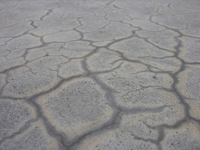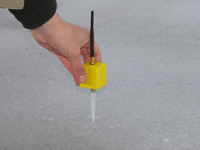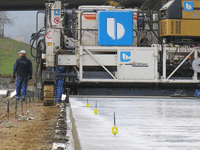Initial situation
In concrete structures, cracking may occur even before the material has reached a significant strength, i.e., within the first few hours after casting. Due to the evaporation of water at fresh concrete surfaces, a capillary pressure is built up in the pore system of the material leading to the so-called capillary or plastic shrinkage and possibly to cracking. Despite the application of concrete curing measures directed toward the reduction of the water evaporation rate, these early age cracks can not always be avoided.


Objective
Based on research results concerning capillary shrinkage of cementitious materials, a wireless sensor system for the on-site measurement of the capillary pressure has been developed. The main objective was the extension of the technical possibilities for preventing early age concrete cracking.
Results
The wireless capillary pressure sensors are plunged into the concrete surface immediately after casting and compaction. When the measurement is terminated, the sensors may easily be pulled out of the concrete. The minimum transmission range of the radio module amounts to 50 m. Because of the real time measurement of the capillary pressure, it is possible to optimize concrete curing measures and to adapt them to the actual climatic conditions. Furthermore, the efficiency of the curing measures may be monitored and documented.


References
V. Slowik, M. Schmidt, D. Kässler, M. Eiserbeck, Capillary pressure monitoring in plastic concrete for controlling early-age shrinkage cracking. Transportation Research Record: Journal of the Transportation Research Board, Volume 2441 / Concrete Materials 2014, 1-5.
M. Schmidt, V. Slowik, In situ measurement of the capillary pressure in concrete road construction. Proceedings of the 12th International Conference on Concrete Roads 2014, September 23–26, 2014, Prague, Czech Republic, 70- Full Paper.pdf, abstract on page 64.
M. Schmidt, V. Slowik, Capillary pressure-controlled concrete curing in pavement construction, I.L. Al-Qadi, S. Murrell (eds.), Proceedings of the 2013 Airfield and Highway Pavement Conference, June 9–12, 2013, Los Angeles, California, American Society of Civil Engineers 2013, 295-306.
M. Schmidt, V. Slowik, Instrumentation for Optimizing Concrete Curing. Concrete International 35(2013)8, 60-64.
EINBLICKE 3/2012 “RESSOURCEN schonen”, Forschungsnewsletter der HTWK Leipzig.
V. Slowik, J.W. Ju, Discrete modeling of plastic cement paste subjected to drying, Cement & Concrete Composites 33(2011)9, 925–935.
V. Slowik, M. Schmidt, Kapillare Schwindrissbildung in Beton – Forschungsbericht zu Ursachen und Auswirkungen sowie zur Vermeidung von Frühschwindrissen, Bauwerk-Verlag, Berlin, 2010, ISBN 978-3-89932-300-9.
V. Slowik, T. Hübner, M. Schmidt, B. Villmann, Simulation of capillary shrinkage cracking in cement-like materials, Cement & Concrete Composites 31(2009)7, 461-469.
M. Schmidt, V. Slowik, Capillary shrinkage cracking and its prevention by controlled concrete curing, K. Kovler ed., Proceedings of the 2nd International RILEM Workshop on Concrete Durability and Service Life Planning – ConcreteLife´09, September 7-9, 2009, Haifa, Israel, RILEM Publications S.A.R.L., Bagneux, France, 2009, 23-30.
V. Slowik, M. Schmidt, Betonrisse im frühen Alter und ihre Bedeutung für die Dauerhaftigkeit der Bauwerke, Forschungsbericht 2009, Hochschule für Technik, Wirtschaft und Kultur Leipzig, University of Applied Sciences, Leipzig, Germany, 43-45.
V. Slowik, Kapillardruckgesteuerte Nachbehandlung von Betonflächen, Transferbrief Leipzig 2/2009, Wirtschaft und Wissenschaft, 6-7.
V. Slowik, M. Schmidt, R. Fritzsch, Capillary pressure in fresh cement-based materials and identification of the air entry value, Cement & Concrete Composites 30(2008)7, 557-565.
V. Slowik, M. Schmidt, A. Neumann, J. Dorow, Early age cracking and its influence on the durability of concrete structures, T. Tanabe, K. Sakata, H. Mihashi, R. Sato, K. Maekawa, H. Nakamura eds., Proceedings of the 8th International Conference on Creep, Shrinkage and Durability Mechanics of Concrete and Concrete Structures – CONCREEP 8, September 30 – October 2, 2008, Ise-Shima, Japan, Taylor & Francis Group, London, 2008, Vol. 1, 471-477.
D. Schmidt, V. Slowik, M. Schmidt, R. Fritzsch, Auf Kapillardruckmessung basierende Nachbehandlung von Betonflächen im plastischen Materialzustand, Beton- und Stahlbetonbau 102(2007)11, 789-796.
Project partners & Industrial partners
Support


